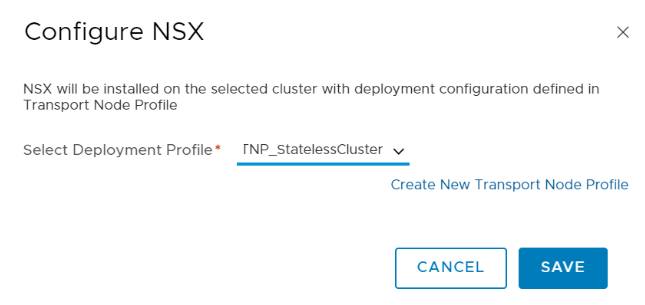NSX-T configuration and installation only happens on the target hosts when TNP is applied to the cluster.
Procedure
- Note down the settings extracted in the Host Profile from the reference host. The corresponding entities in the TNP profile must have the same value. For example, the N-VDS name used in the Host Profile and TNP must be the same.
For more information on extracted host profile settings, see Extract and Verify the Host Profile.
- Add a TNP. See Add a Transport Node Profile.
- Add a TNP by entering all required field. See Add a Transport Node Profile.
Ensure that values of the following parameters are the same on both the new TNP profile and the existing Host Profile.Note: On a VDS switch, migration of VMkernel adapters and physical NIC migration is not supported.
-
Transport Zone: Ensure transport zone referenced in Host Profile and TNP is the same.
-
N-VDS Name: Ensure N-VDS name referenced in Host Profile and TNP is the same.
-
Uplink Profile: Ensure uplink profile referenced in Host Profile and TNP is the same.
-
Teaming Policy:
- (On a VDS switch) In vCenter Server, when creating VDS uplinks, verify the NIC used in the Host Profile and map that physical NIC to the VDS uplink. In NSX-T, you map NSX-T uplinks to VDS uplinks. So, verify the configuration on the VDS switch in vCenter Server.
- (On an N-VDS switch) When mapping a physical NIC to an uplink profile, first verify the NIC used in the Host Profile and map that physical NIC to the uplink profile.
- Network mapping for install: When mapping network during installation, first verify the VMkernel to logical switch mapping on the Host Profile and add the same mapping in TNP.
-
Network mapping for uninstall: When mapping network during uninstallation, first verify the VMkernel to VSS/DVS switch mapping on the Host Profile and add the same mapping in TNP.
 After applying TNP on target nodes, if the TNP configuration does not match Host Profile configuration, the node might not come up because of compliance errors.
After applying TNP on target nodes, if the TNP configuration does not match Host Profile configuration, the node might not come up because of compliance errors. -
- Verify that the TNP profile is successfully created.
- Apply TNP profile to the target cluster and click Save.

- Verify that the TNP profile is successfully applied to the target cluster. It means that NSX is successfully configured on all nodes of the cluster.
- In vSphere, verify that the physical NICs or VMkernel adapters are attached to the N-VDS switch.
Note: On a VDS switch, VMkernel adapter migration is not supported.

- In NSX, verify that the ESXi host is configured successfully as a transport node.
What to do next
Alternatively, you can reboot a target host after applying TNP to the cluster. See Reboot Hosts After Applying TNP.